Sailing Yacht “Light Blue” — a Yachting Monthly Offshore 38
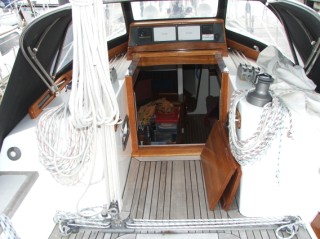 Looking into the galley area from the cockpit
Looking into the galley area from the cockpit
A potted account of the making of the ideal long-distance steel sloop, her design and performance attributes
In 1989, Yachting Monthly, the UK’s most popular sailing magazine published the Offshore Yacht series. A team comprised of experts drawn from the magazine’s editorial line-up and the yachting world pooled their expertise and examined in minute detail every aspect of offshore yachts to discover where improvements could be made. From their recommendations, the imaginary “ YM Offshore 35” was designed, but was never built, due probably to the expensive production costs.
In 1990, however, Sirius Yachts, builders of the David Thomas-designed Sirius 42 ocean cruiser, agreed to progress the project, making one conceptual change by lengthening the hull by three feet to 38. The plan to build an ideal live-aboard ocean-going yacht for a couple to sail wherever they wished in safety was born. David Thomas, the top naval architect, who had been one of the original panel of experts designed the state of the art cruiser, embodying practicality with strength and excellent performance potential.
Instead of describing what proposals were made for her, I will describe the fine points of the amalgam, which has resulted from the outpouring of focussed minds and dream of the previous owner and now my wife and I. In brief, suffice it to say that most of the brilliantly deliberated ideas were incorporated in her fabrication.
Construction
Her round bilge hull is 4mm steel, fabricated with narrow vertical plating over multiple T-bar stringers, which has resulted in a fair and immensely strong hull. Deck and upperworks are also steel, with the cockpit overlaid in teak. Her keel is of 8mm steel plating filled with lead. The fact that hull, deck, coach roof and keel are monocoque has added to the overall strength of the boat as a whole.
Rig
Inspired largely from the BOC Around the World Race, she has a light airs masthead genoa on the furling forestay for winds up to 10 knots apparent. For stronger winds this sail is replaced by the working jib, which is of heavier material and closer to the centre of gravity. It is of fractional proportions, radially cut with a high clew, which makes it an excellent reefing sail. It will be carried up to storm force when it is replaced by a strongly constructed spitfire storm jib. The suit of Hood sails is extensive, with a fully battened mainsail, (three reefing points), two spinnakers, a cruising chute and a trysail. For ease of handling all lines are led aft to the cockpit. Her standing rigging, which has been replaced in December 2005, is overstrength and the mast, which is supported on all sides by shrouds, forestay and twin backstays, carries twin running backstays to further lend support, when reaching.
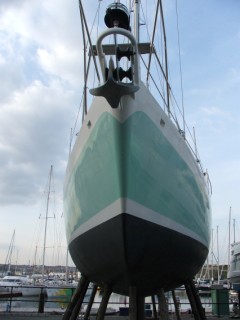
On deck
The sidedecks are wide, uncluttered and solid underfoot because of the non-slip paint coating over the steel deck. Strongly mounted stainless steel grab rails are well placed and stanchions are particularly strong, all of which contributes to the overall sense of strength and reliability. The anchor stows on substantial rollers, well clear of the hull plating in a short cathead cum bowsprit, to which is attached the masthead forestay. The anchor chain runs to the hawse pipe at the aft end of the sunken anchor well and then through the windlass, which is situated in a covered flush sunken well on the starboard sidedeck. The chain stows in the centre of the hull below the cabin sole to keep the weight as low as possible, thus adding to the ballast of the lead keel.
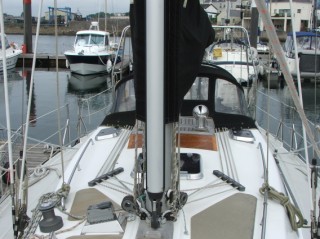
Extra points
To overcome the inevitable curse of steel boats of the rust streaking that results when the protective layer of paint is breached, the designer and producer sought to eliminate or minimise this by using stainless steel in those areas, which take the most knocks. The toe rail and the stanchion bases were therefore made from stainless steel, as is the bow roller assembly, which gives the yacht her clipper bowed appearance.
To further assist in retaining the paint, all edges are radiused and it is this aspect of the design, which gives the boat the appearance of a non-steel craft. Effective insulation with the use of fire retardant foam means the boat is not subject to the booming empty oil drum noise of most steel yachts and walking along the deck is noise free.
Hull
Her form was dictated by her intended function and her underwater lines are not dissimilar to those of other dedicated long distance yachts, such as Hallberg Rassey, Bowman and Najad. She has a classic modern blue water cruiser shape with a canoe body, longish fin keel, a deep foil rudder supported by a full depth skeg for directional stability and strength. The steel construction, combined with the deep body, allows the lead ballast encapsulated in the keel to be carried low and engine, tankage and batteries are also located well below the waterline.
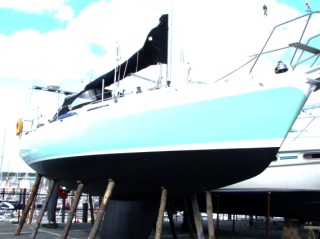
Interior
The interior is geared towards practicality and ease of use at sea rather than in harbour, as her concept was based upon the assumption that one or two people would sail her. Although she is not spacious by modern standards, there is ample accommodation in the operational parts of the boat, such as the galley, chart table and companionway. I can walk throughout the boat without stooping ( 6’ 6” headroom throughout )and the bunks are ample for someone of my 6’ 1” height. The white painted lining of the saloon provides her with a reflected brightness and ease of maintenance.
The chart table is large, faces outboard with a fascia filled with a complete range of navigational instruments and electrical control panel. There is a swing out seat, which can be tucked out of the way under the chart table when not in use.
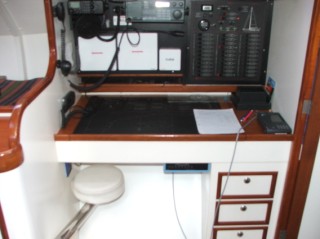
The galley design has been well thought out, with the twin sinks on the centreline to allow for easy drainage on either tack, with a large expanse of worktop. The front loading fridge is huge and so convenient in contrast to the normal dive-in cavern type cool box.
Stowage space in lockers under and behind the saloon seating is voluminous and Siobhan and I have divided Light Blue into “Hostess’s Pantry” on port side and “Bosun’s Locker” on starboard.
There is an abundance of hand-holds throughout, with wooden grabrails running along both sides at shoulder height. The forepeak is purely functional with a workbench to starboard and stainless steel sail bin cum pipe cot to port. I imagine that it will become the storeroom for everything from bimini to paints, trollies to spare halyards etc.
“Light Blue” should not be compared with the modern wide beamed GRP mass production yachts in respect of the aft cabin, which again is functional, giving access to the machinery and systems. The double bunk is comfortably big enough for Siobhan and me, and with the minimum hiproom of 18 inches under the cockpit sole, it is a good job that Siobhan is slim. There is however plenty of stowage under the mattress and along the side of the cabin.
The heads are adequate for the size of the boat and luxurious compared with other boats on which we have sailed , with large locker space and a heated towel rail. With a water-maker on board, daily showers will be a boon in the tropics.
The cockpit
Bearing in mind that “Light Blue” is designed for 1 to 3 persons to sail in comfort, the cockpit is spacious yet allows one to brace oneself when heeled. The cockpit is linked to the saloon by a wide and deep bridgehead, ideal for keeping a comfortable watch in stormy conditions with safety loops for harnesses conveniently placed. The scoop stern and open transom would greatly assist in recovery of man overboard, while for everyday cruising, acts as an easy access point for loading and unloading to and from the dinghy, low level diving platform and swimmers’ entrance.
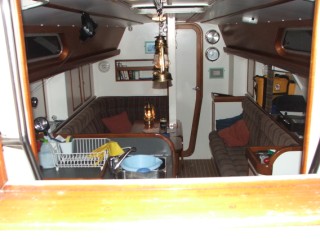
A strong stainless steel goalpost surmounts the rear of the cockpit, supporting radar and other antennae, cockpit light and upon which one could mount a solar panel. It acts as an attachment point for the bimini and provides grabbing points over the rear of the cockpit. The starboard cockpit locker is large enough to climb into and provides ample space for larger sailing items such as the dinghy, fenders, shopping trolley, liferaft and grab bags. The life raft stows within the steel fabricated helmsman’s seat, while underway. On the opposite side of the cockpit is a large glazed Lewmar hatch, sufficient in size to act as an escape route from the stern cabin in case of galley/saloon fire.
Performance
I think Drummond Challis, the previous owner, summed up her overall performance during the making of the film about the building of “Light Blue”, when he said that he didn’t want to leave the helm at the end of his watch. We have found her an absolute pleasure to sail, with a long legged feel to her, speeds of 6.5 knots easily achieved mile after mile in Force 4/5 winds, lightly balanced helm and easily managed sail configuration, due I would estimate to the design of the hull, choice of sails and the close attention to the positioning of all the sail trimming equipment.
During our recent triangular voyage from Plymouth to France, the Channel Islands and return, we had immense fun putting her through her paces. It gave us a foretaste of what is to come when we set off on our life adventure in June 2006. Our intention is to circumnavigate Ireland, cross over to Vigo in Northern Spain, pass along the Portuguese coast to Madeira, then to the Canaries and across to the Caribbean. We will pass north along the Windward and Leeward islands before sailing up the East coast of the USA. We plan to take a year to cover those areas and we will then decide where next. We will be taking one step at a time and keeping in touch with friends and relatives through this website. Ireland first step. Watch this space!